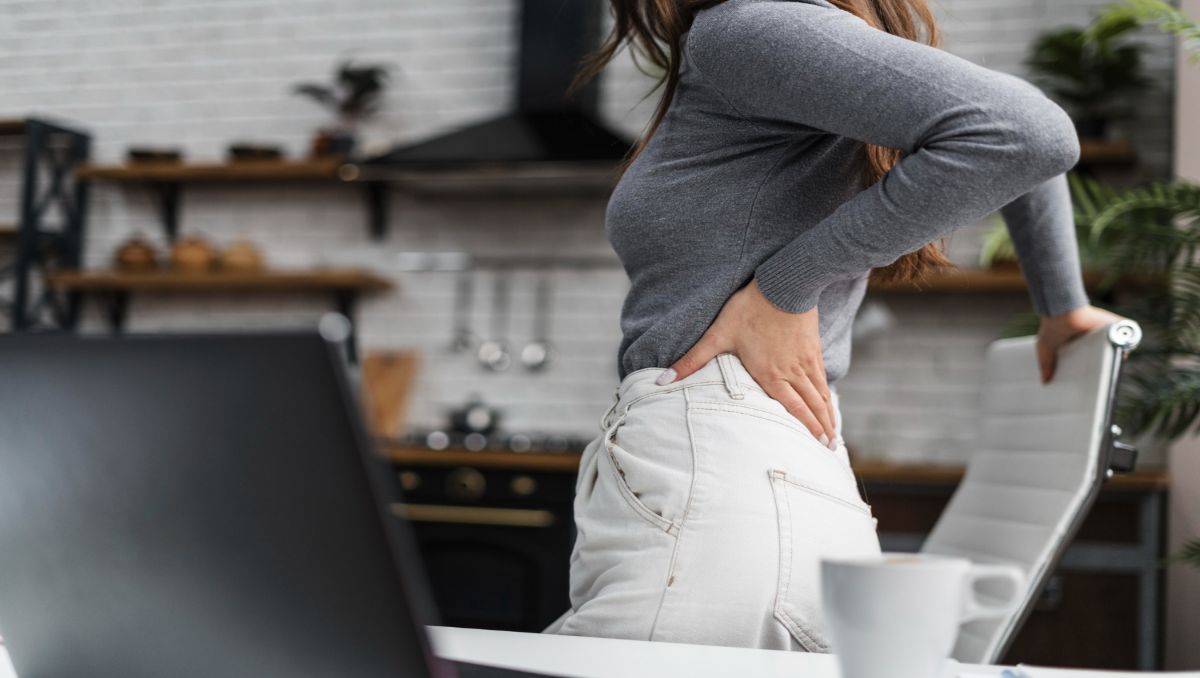Hip pain can transform a productive workday into an agonizing ordeal. For those spending long hours seated, the right ergonomic office chair isn’t a luxury; it’s a necessity. An ill-fitting chair can exacerbate existing hip issues or even create new ones, leading to discomfort, reduced mobility, and decreased productivity. Choosing the best office chairs for hip pain requires a thoughtful approach, considering ergonomic features, adjustability, and support.
Key Takeaways:
- Choose a chair with adjustable lumbar support, seat height, and armrests to keep your hips properly supported and reduce pain.
- A chair that tilts or reclines helps you change positions frequently, which reduces pressure on your hips and keeps you comfortable.
- A medium-firm cushion made of memory foam or gel helps distribute pressure evenly and provides the support you need to avoid discomfort.
In this guide, we’ll explore the key factors to consider when selecting an office chair designed to alleviate hip pain.
Understanding Hip Pain and Its Impact on Office Work
Hip pain is discomfort or soreness in the hip joint or surrounding muscles, and it’s often caused by things like a sedentary lifestyle or poor posture. Sitting for long periods, especially with improper posture, can cause the muscles around the hip to tighten and weaken. Over time, this leads to stiffness and pain. Conditions like arthritis, sciatica, or muscle imbalances can also contribute to hip discomfort, making it harder to move comfortably throughout the day.
Chronic hip pain can have a serious impact on your productivity at work. It can make it difficult to focus, as discomfort often distracts from the task at hand. Sitting for long hours with pain can also cause fatigue and reduce your efficiency. If you’re constantly adjusting your position to find relief, you may feel less comfortable and less focused on your work. If you’re noticing symptoms like hip stiffness, soreness, or fatigue, it might be time to invest in an ergonomic chair that supports better posture and reduces the strain on your hips.
Dr. Sean Ormond, a pain management doctor of Atlas Pain Specialists, shares this about hip pain:
“Poor sitting habits can also contribute to hip impingement, which is when parts of the hip joint don’t move smoothly, causing pain.”
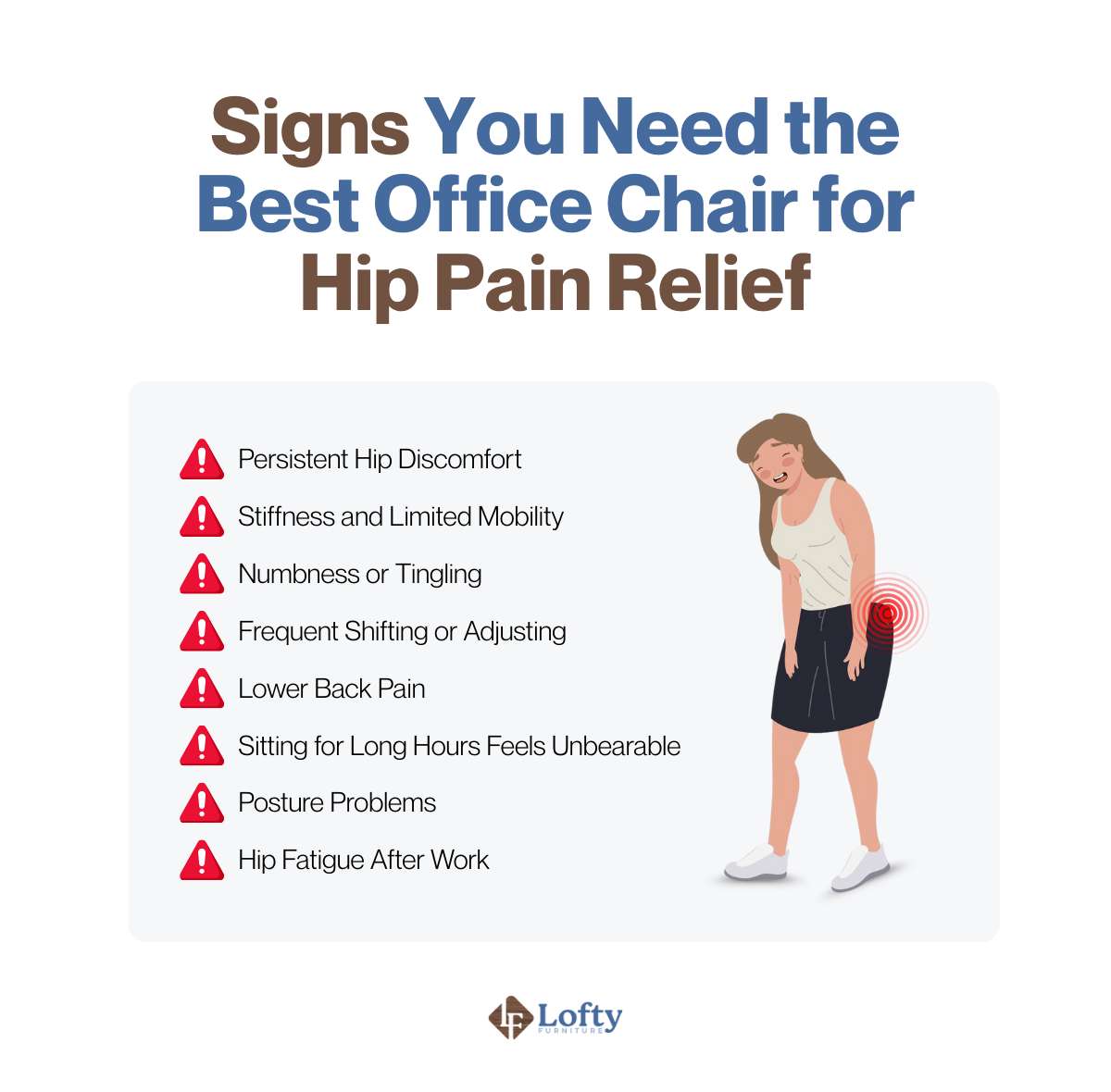
Key Features to Look for in The Best Office Chairs for Hip Pain Relief
Choosing the best office chairs can significantly alleviate hip pain by providing proper support. Dr. Sean highlights the importance of adjustability and mobility of some of the chair’s key features. He says:
“The more adjustable the chair, the better. It gives you the flexibility to find the most comfortable and supportive position for your body.”
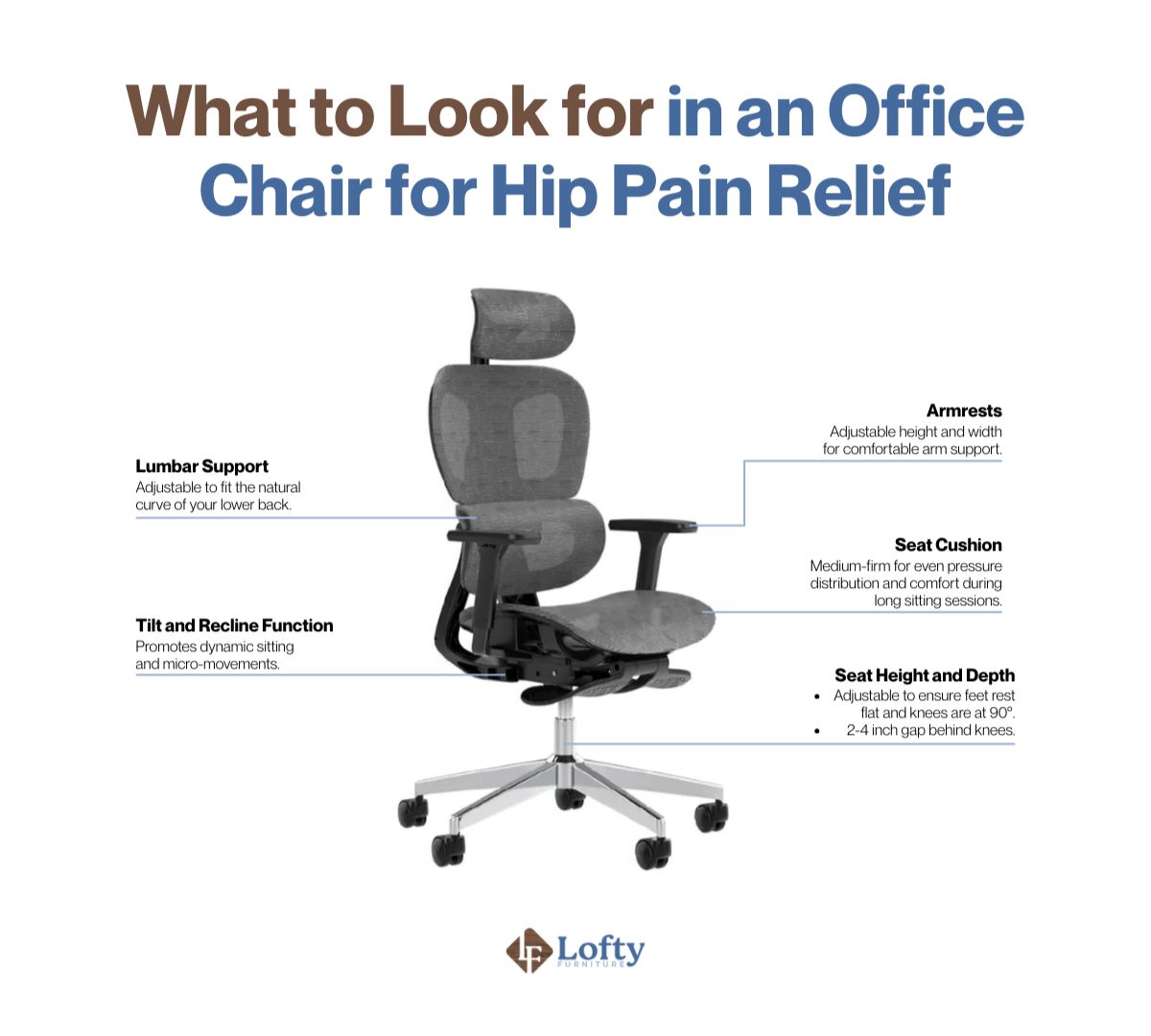
Here’s a breakdown of the essential features to consider:
Good Adjustable Lumbar Support
Good lumbar support is key to keeping your spine aligned and relieving pressure on your hips. To check if the support fits right, sit back and make sure it fills the gap in your lower back, creating a natural “S” curve in your spine.
Seat Height, Depth, and Width Adjustment
The right seat height and depth are crucial for proper alignment, with the seat height allowing your feet to rest flat and your knees at a 90-degree angle, while seat depth leaves a 2-4 inch gap behind your knees. Adjust the seat height with the lever under the seat and use the sliding mechanism to change the seat depth.
Adjustable Armrests
Armrests play a vital role in supporting your upper body and reducing strain on your shoulders and hips. Proper armrest height allows your arms to rest comfortably at your sides, reducing tension in your shoulders and preventing slouching. Adjustable width armrests ensure your arms are properly supported, regardless of your body size.
Tilt and Recline Function
Dynamic sitting and micro-movements help improve circulation and reduce hip pressure, and tilt and recline features let you adjust your posture throughout the day. Regularly using these functions can evenly distribute pressure and ease hip pain, as Dr. Sean explains:
“A chair that can recline a little can help reduce pressure on your hips. A slight recline encourages a more relaxed posture and relieves tension in your lower body. But don’t overdo it—too much recline might cause other issues, so it’s about finding that sweet spot where your body feels supported.”
Seat Cushion Material and Firmness
The seat cushion material and firmness are key for comfort and pressure relief, with options like high-density memory foam and gel cushions conforming to your body and reducing pressure points. A medium-firm cushion provides the right balance of support without being too hard or soft. Here’s what Dr. Sean has to say:
“Breathable fabrics like mesh allow air circulation, which helps keep you cool and comfortable during long hours of sitting. Materials like leather or vinyl might feel nice, but they can trap heat and make you uncomfortable.”
Here’s a table comparing different seat cushion materials based on pressure distribution, breathability, durability, and suitability for hip pain:
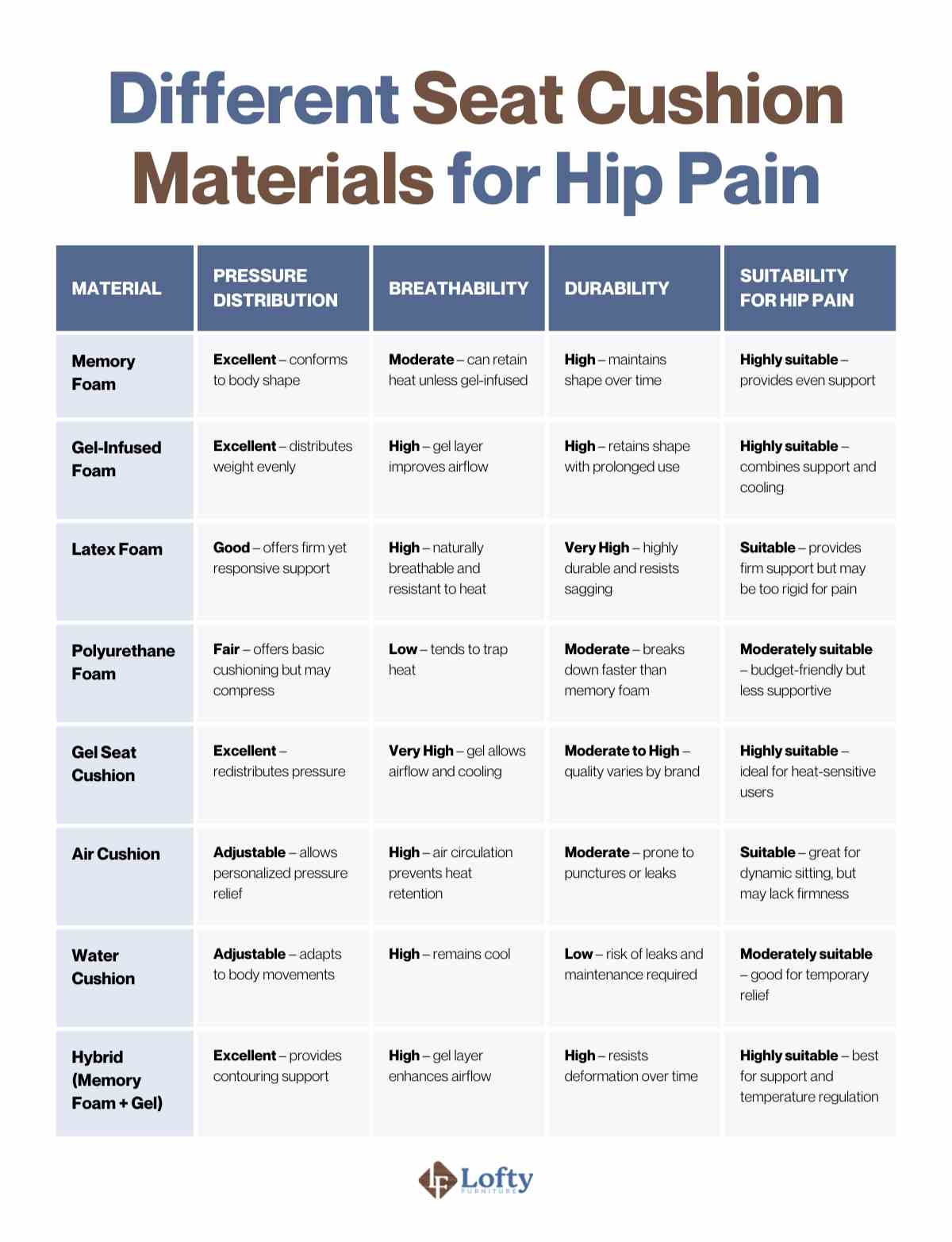
Specific Chair Types and Recommendations
Beyond individual features, certain types of office chairs are designed with ergonomic principles in mind. Here’s a look at some recommended best office chairs for hip pain.
Ergonomic Office Chairs
These chairs are designed with a focus on adjustability and support, often incorporating features like adjustable lumbar support, seat height and depth, and armrests. Ergonomic chairs are generally considered the gold standard for office seating, as they allow for a high degree of customization to fit individual needs and body types, making them a versatile and effective option for managing hip pain.
Ready to upgrade your comfort and banish hip pain? Explore our selection of modern ergonomic chairs designed for all-day support.
Mesh Chairs
Mesh chairs offer breathability and some degree of ergonomic support, often featuring a mesh backrest that conforms to the user’s spine. The mesh material allows for air circulation, preventing overheating during prolonged sitting. Some high-end mesh chairs also include adjustable lumbar support and other ergonomic features, enhancing their suitability for hip pain relief.
Kneeling Chairs
Kneeling chairs are designed to promote an open hip angle and encourage a more upright posture, reducing pressure on the lower back and hips. While they may take some getting used to, kneeling chairs can be a valuable option for those seeking to alleviate hip pain and improve posture. However, they are not ideal for all-day use and should be used in rotation with other seating options.
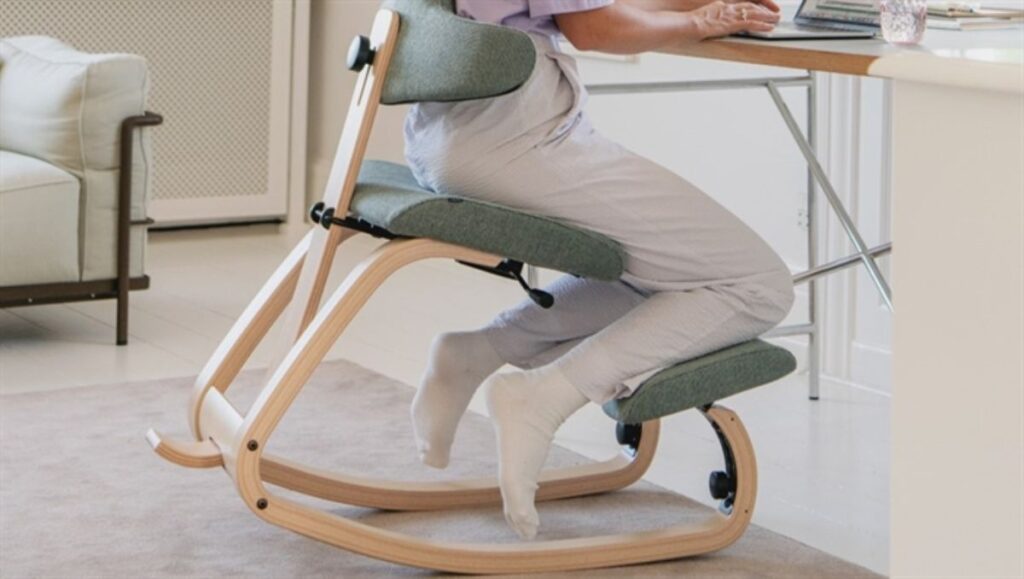
Balance Ball Chairs
Balance ball chairs engage core muscles and promote active sitting, encouraging subtle movements and postural changes throughout the day. By requiring users to maintain balance, these chairs help strengthen core muscles and improve stability, which can indirectly alleviate hip pain. However, they are best used for short periods or as a supplement to a traditional office chair.
Standing Desk Chairs/Stools
These chairs and stools are designed for use with standing desks, providing support during periods of standing. They often feature adjustable height and a leaning or perching design, allowing for a semi-standing posture that reduces strain on the hips and spine. Standing desk chairs/stools offer a dynamic alternative to traditional sitting, promoting movement and reducing static loading.
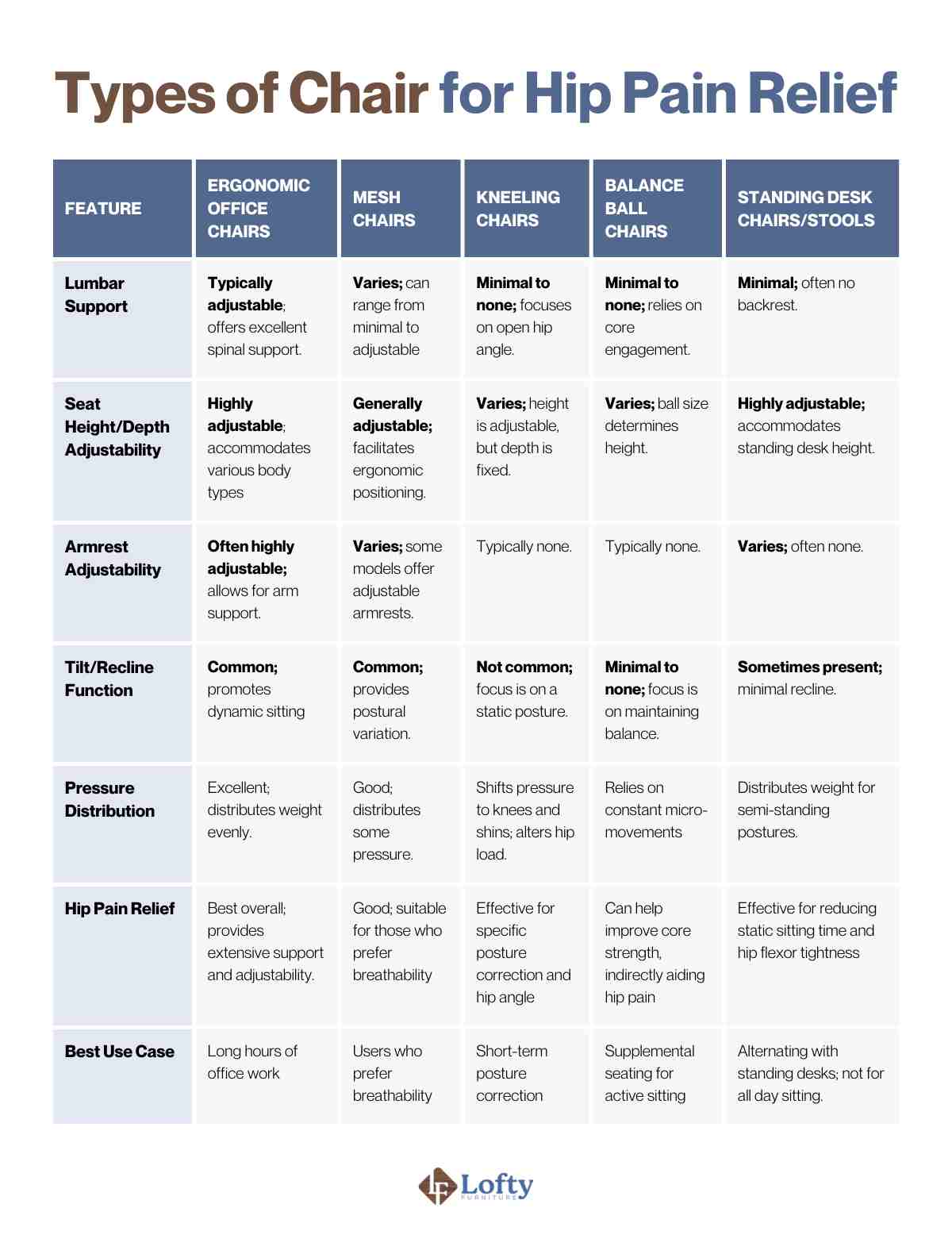
Setting Up Your Chair for Optimal Hip Support
Proper chair setup is crucial for maximizing hip support and minimizing pain. Start by adjusting the seat height so your feet rest flat on the floor and your knees form a 90-degree angle. Ensure there’s a 2-4 inch gap between the back of your knees and the seat’s edge to prevent pressure on the popliteal area. Adjust the seat depth to support your thighs without reaching the back of your knees.
Fine-tune the tilt and recline functions to promote dynamic sitting, allowing for occasional postural changes and micro-movements. Ensure the seat cushion is firm enough to provide support without being too hard. Regularly check and readjust your chair settings throughout the day, as your posture and comfort needs may change. Consider using additional support, such as a lumbar cushion or footrest, if needed.
Additional Tips for Hip Pain Relief
Besides getting a good chair, Dr. Sean adds:
“While a supportive chair is important, it’s also essential to take breaks. Using a footrest or small cushion under your hips might also help for extra comfort. If hip pain continues, seeing a professional for personalized treatment is a good idea.”
So here are additional strategies to alleviate hip pain:
- Exercises and Stretches: Incorporate hip flexor stretches and glute bridges into your daily routine. Gentle range-of-motion exercises can reduce stiffness.
- Regular Movement and Breaks: Take short breaks every 20-30 minutes to stand, walk, or stretch.
- Proper Desk Setup and Ergonomics: Ensure your monitor is at eye level to prevent neck pain, which can affect posture and hip alignment.
- Hydration: Proper hydration is important for joint health. It helps keep the synovial fluid that lubricates your joints healthy.
- When to Seek Professional Medical Advice: If hip pain is severe, persistent, or accompanied by other symptoms (e.g., fever, swelling, numbness), consult a healthcare professional.
Watch this video to learn more tips to relieve hip pain while sitting:
Conclusion: Investing in The Best Office Chairs for Hip Pain
Choosing the right ergonomic chair and implementing ergonomic strategies are crucial for alleviating hip pain. By prioritizing adjustable features like lumbar support, seat height, and armrests, and incorporating dynamic sitting principles, you can create a workspace that supports your well-being. Coupled with regular movement and professional guidance when needed, you can reclaim comfort and productivity with the best office chairs for hip pain.
FAQs
How does active sitting contribute to reducing hip discomfort during prolonged desk work?
Active sitting involves making subtle movements and postural changes throughout the day. This reduces static loading on the hips and spine, promotes better circulation, and engages core muscles, preventing stiffness and discomfort.
How do I adjust my ergonomic chair for optimal hip support?
Begin by adjusting the seat height so your feet rest flat on the floor and your knees form a 90-degree angle. Ensure a 2 to 4-inch gap between the back of your knees and the seat edge. Regularly check and readjust settings throughout the day to accommodate your changing needs.
When should I seek medical advice for hip pain related to sitting?
Seek medical advice if your hip pain is severe, persistent, or accompanied by other symptoms like fever, swelling, or numbness. If ergonomic adjustments and exercises don’t provide relief, a healthcare professional can diagnose the underlying issue and recommend appropriate treatment.
